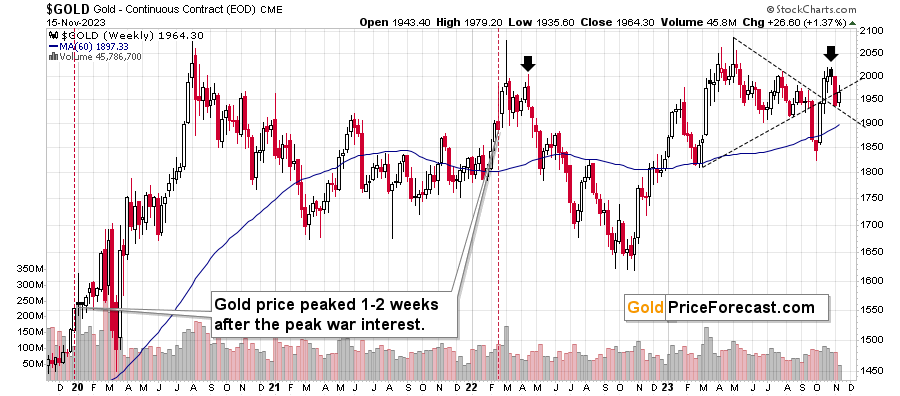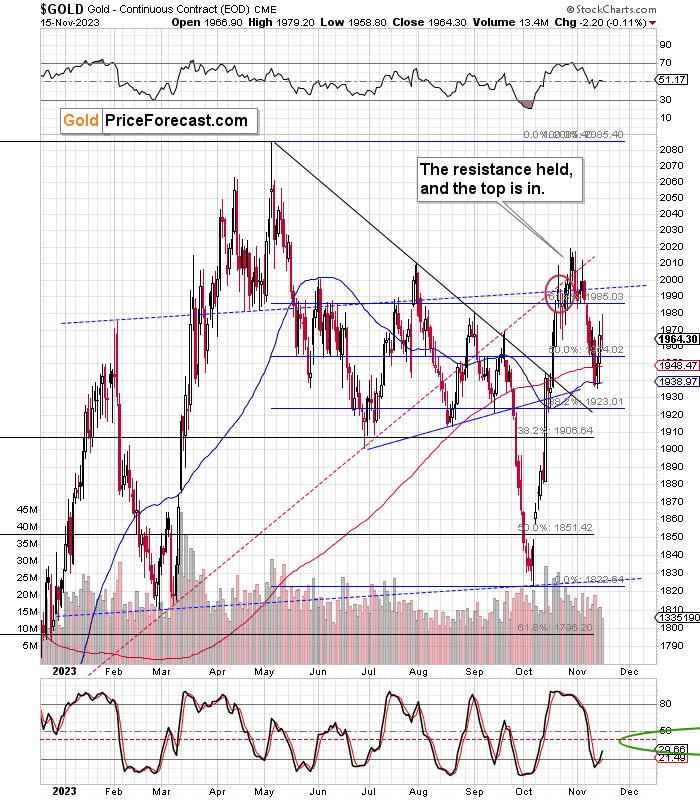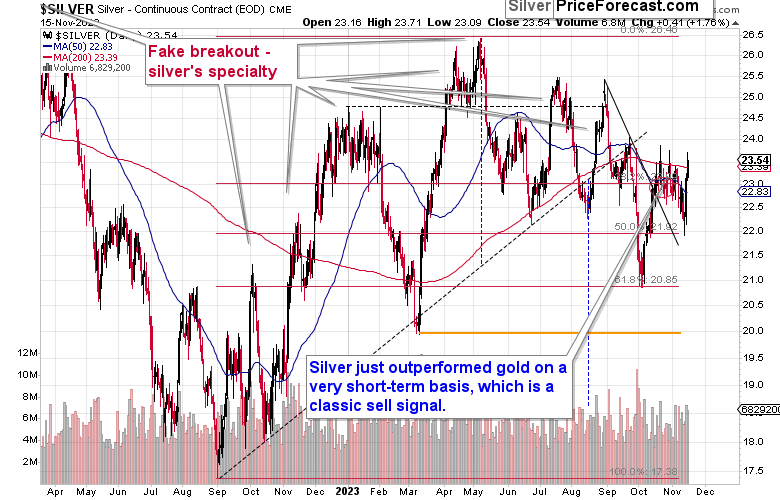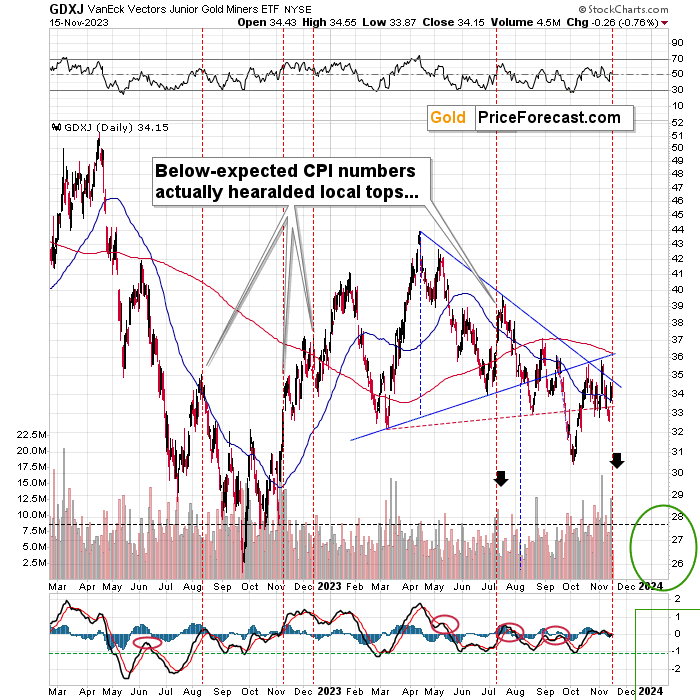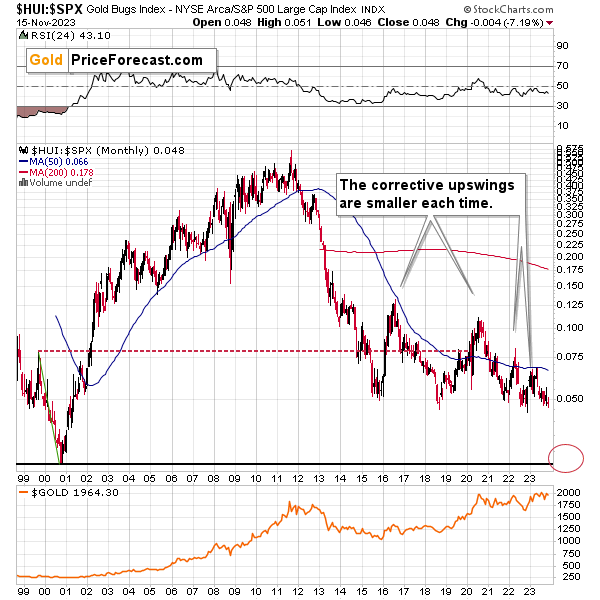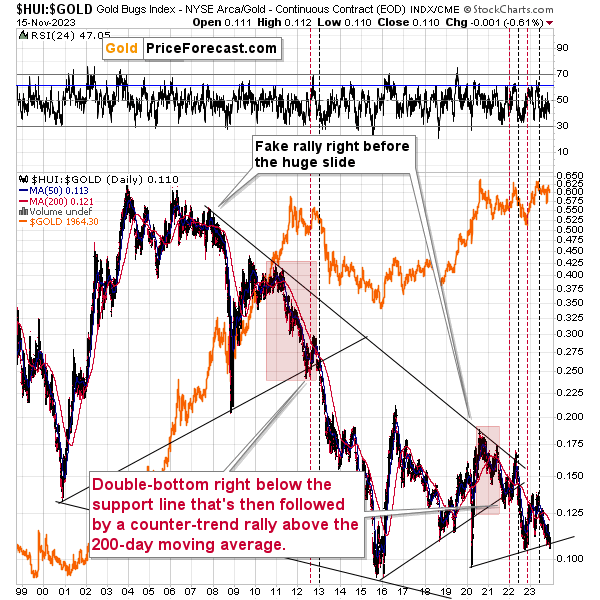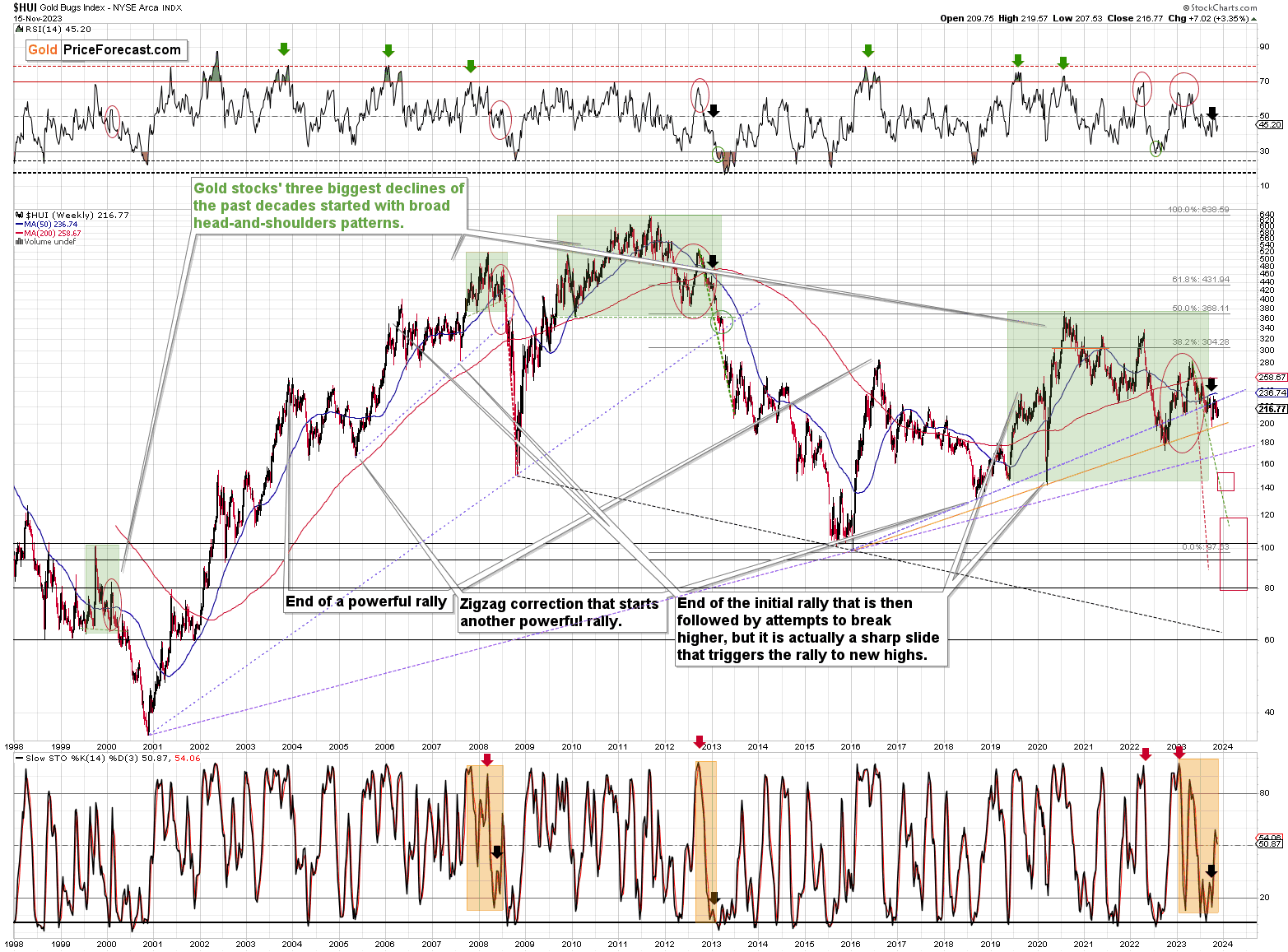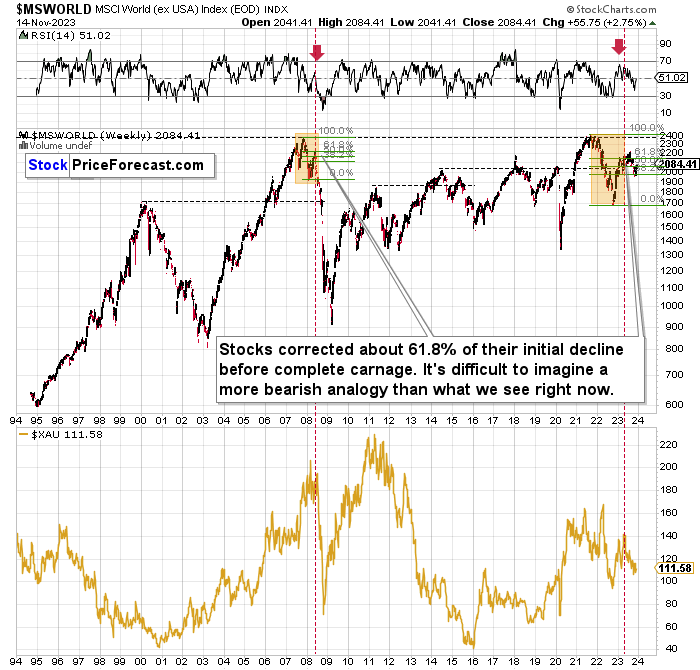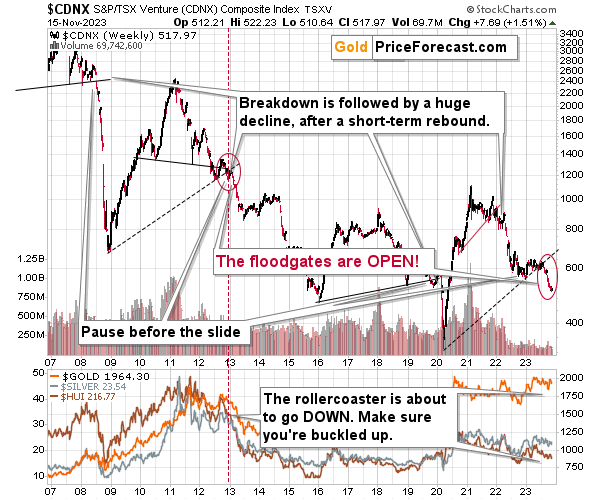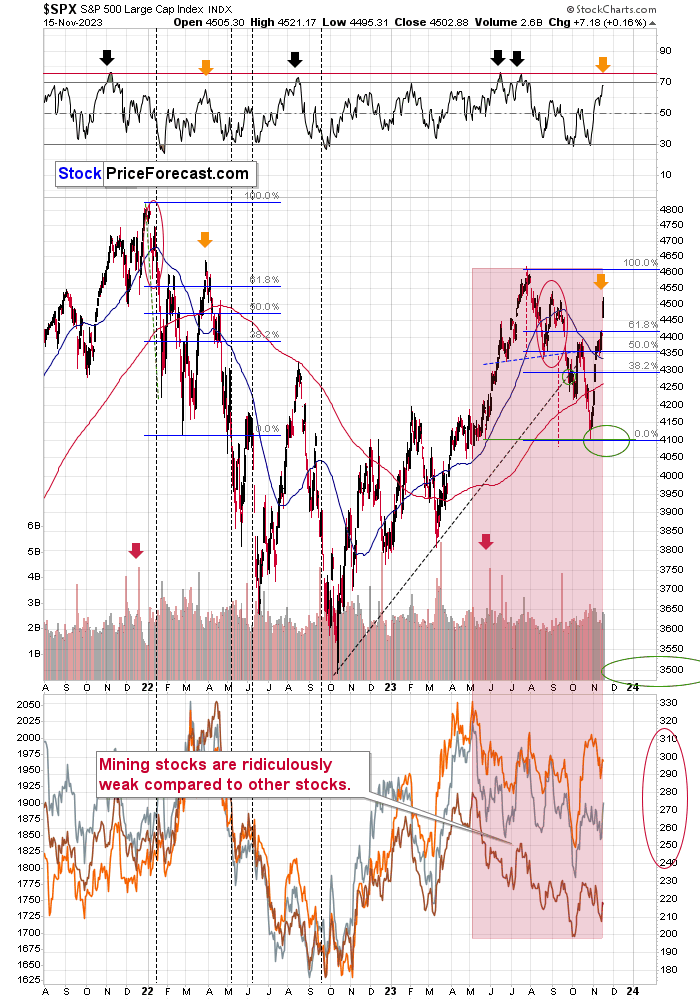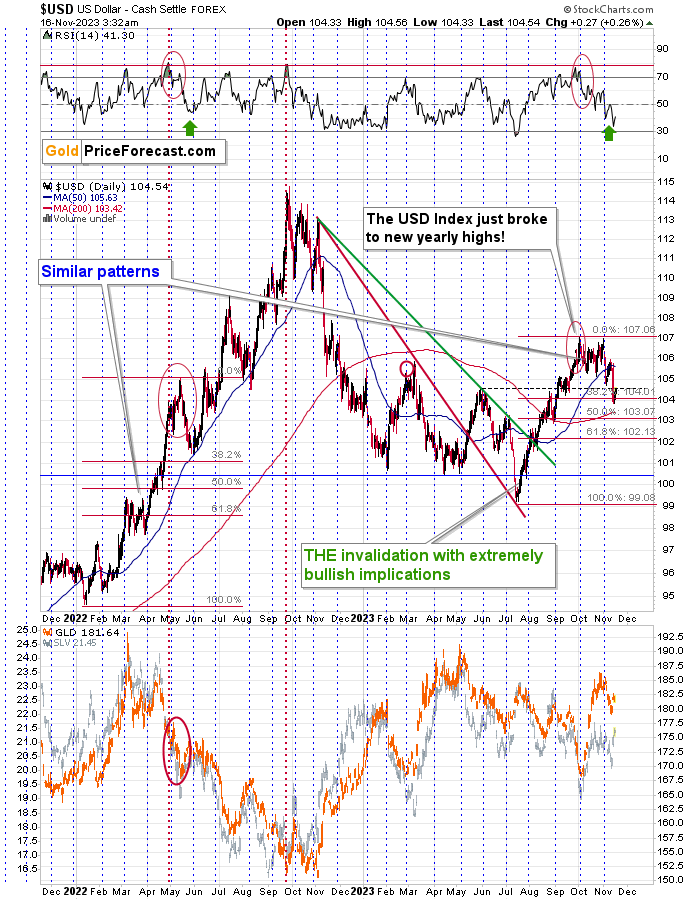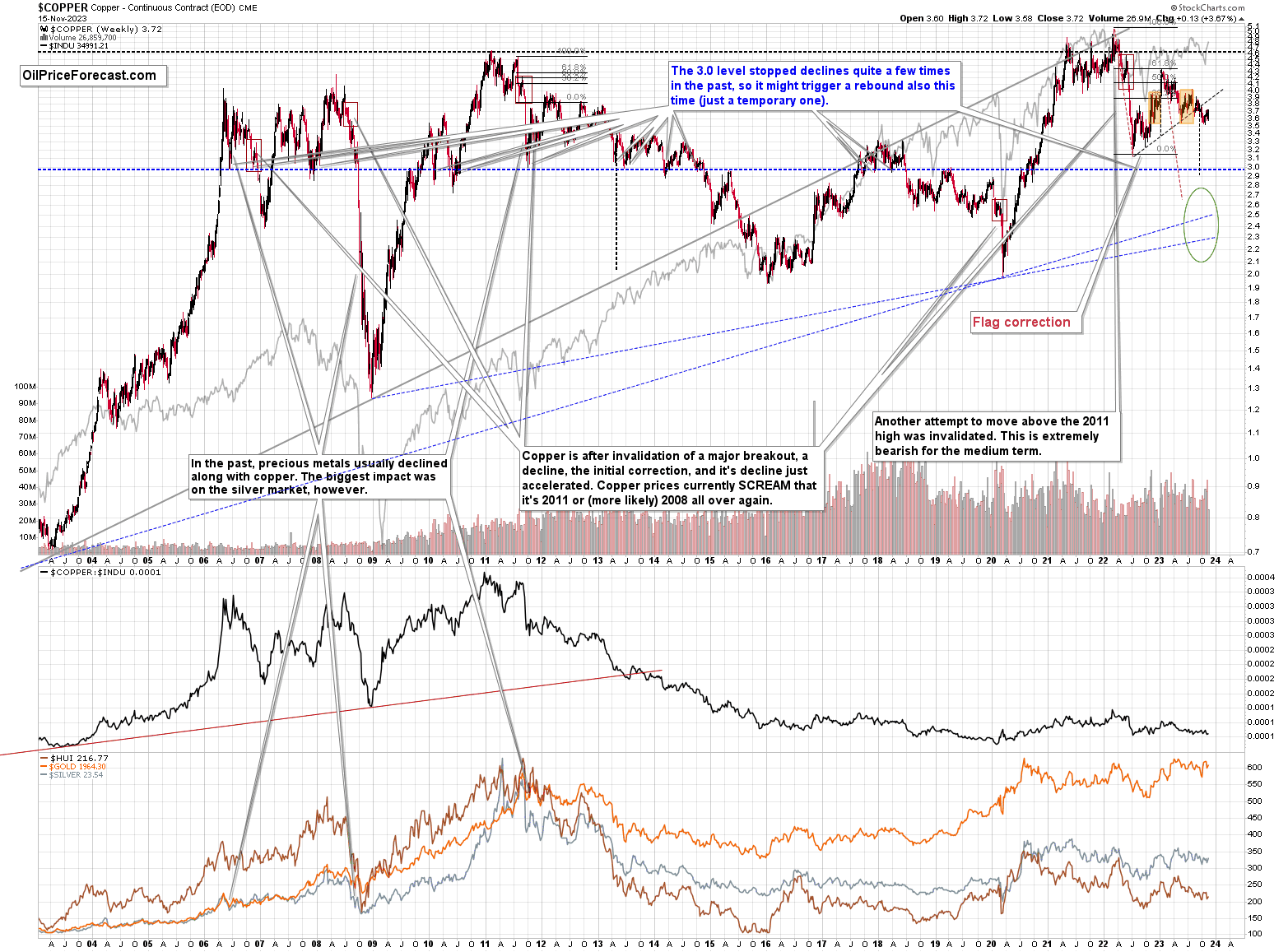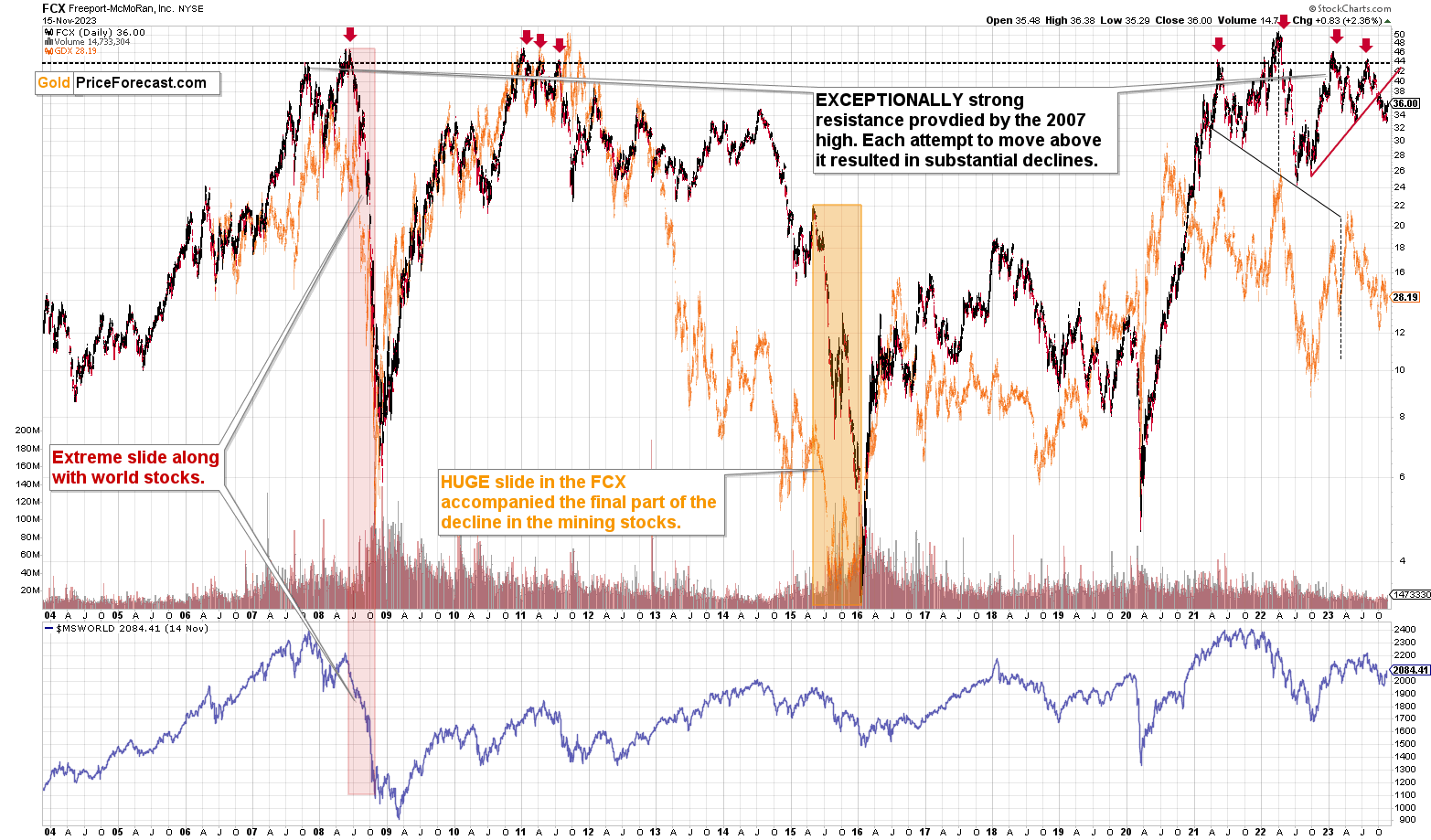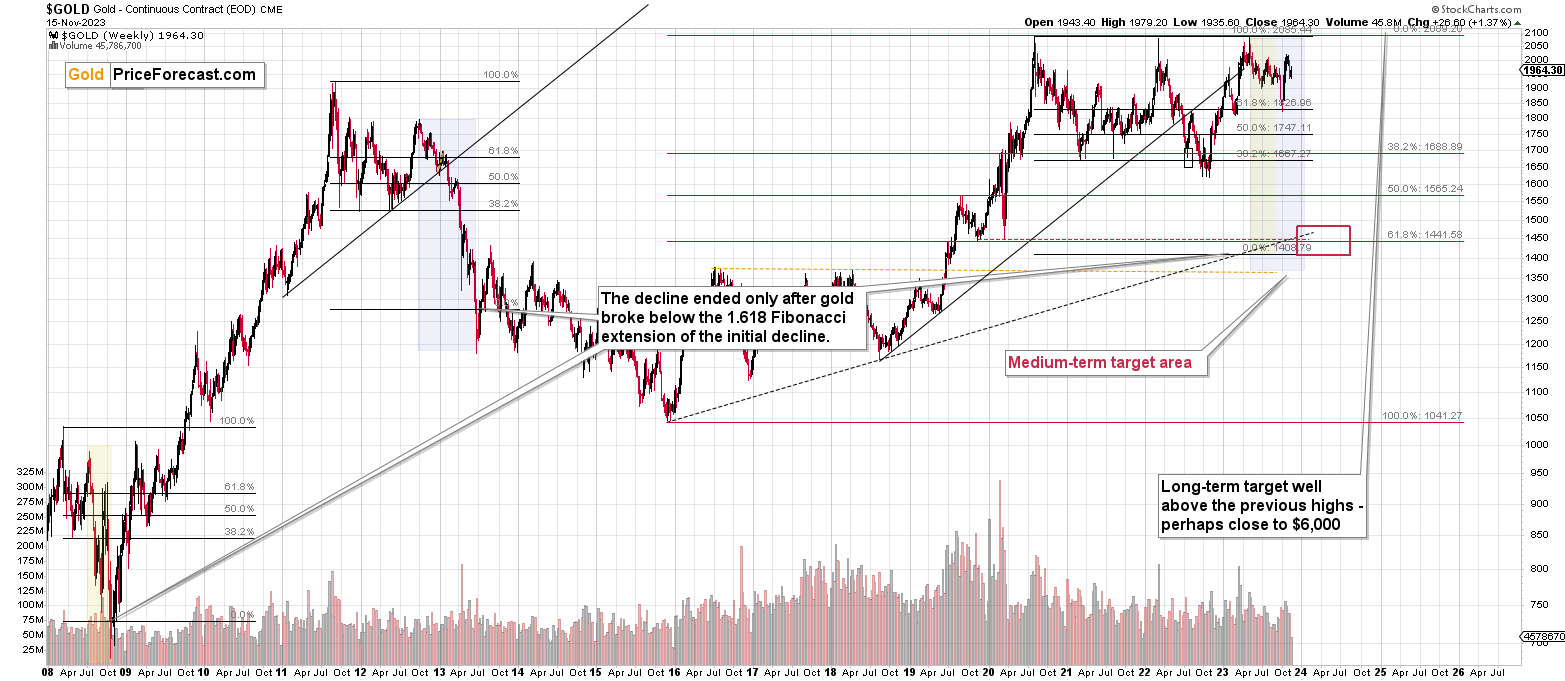Briefly: in our opinion, full (300% of the regular position size) speculative short positions in junior mining stocks (GDXJ) are justified from the risk/reward point of view at the moment of publishing this Alert.
Some might consider an additional (short) position in the FCX.
That’s all, folks. Whatever “bullish news” for gold was likely to happen has likely already happened. And you know what happens next? Declines.
The nonfarm payrolls were lower than expected, and miners rallied. Temporarily only, but still.
The CPI numbers were also lower than expected, and the precious metals sector moved higher. Once again, most likely temporarily, based on the analogy to the previous similar situations.
And the situation in the Middle East? It continues to be very tense. And yet, the concern with “war” in general is already after its peak and is now declining.
All three above factors should have made the precious metals sector move much lower. And did they? The situation in the Middle East did cause gold to move higher, as it’s a safe-haven asset, but gold didn’t move above its 2022 high when the analogous concerns regarding Ukraine arose.
And… both wars are still taking place, and gold still failed to hold above $2,000. It’s trading pretty much where it topped 12 years ago, while silver and gold stocks are not even close to their 2011 highs.
Massive bull market in the precious metals sector?
No.
It was a local response to military conflicts in the case of gold. Silver and mining stocks continue their downward trends in a clear manner. The same goes for platinum and palladium. Gold is the exception.
Now, since the bullish news already happened, what kind of surprises await the precious metals market in the following days? Bearish ones. People already extrapolated the bullishness to the following days, and the precious metals sector likely moved too high too fast. Especially that… the real rates moved higher based on the recent move lower in CPI and core CPI.
From the weekly point of view (after three sessions in the case of this week), we see that gold simply corrected after moving to its declining support line, but it failed to hold above its rising resistance line.
This means that the recent move higher is likely a regular breather.
Please note the moments marked with arrows. That’s when gold topped after the concern with “war” (based on Google Trends’ data) peaked. Any back-and-forth movement here should be viewed as smoke and mirrors before the big move happens. And the big move is likely to be to the downside – just like what we saw in 2022.
From the short-term point of view, we see that gold just reversed yesterday. We might have just seen the local top.
The interesting thing about this recent upswing is how much silver rallied compared to the rally in gold.
The white metal soared and almost touched its October highs! Gold was nowhere close to those levels. In other words, silver just outperformed gold on a very short-term basis. If you’ve been following my analyses for some time, you know that this is something that we often see right before bigger declines.
Mining stocks, however, did not move close to their October high this week. This makes silver’s strong performance stand out even more – making it even more bearish.
The vertical, dashed lines on the above chart mark the situation when CPI statistics were below expectations.
- Back in August 2022, it was practically right at the top, which was followed by a sizable decline.
- In November 2022, it was right before a local top.
- In December 2022, it was practically right at the local top.
- In July 2023, it was right before a local top, which was followed by a sizable decline.
What are the implications? They are unclear for the immediate term (1-3 days), bearish for the short-term (1-2 weeks), and likely bearish also for the medium-term (several weeks).
The reason for the latter is that the medium-term trend in the mining stocks is clearly down, and the fact that junior miners clearly underperformed both gold and the general stock market in recent weeks, confirms this bearish gold forecast.
Besides, the reaction of the precious metals market was weak in general – at least when compared to what happened in stocks and in the USD Index.
Remember when, on Nov. 6, I told you that negative surprises in nonfarm payrolls are not necessarily a bullish thing despite the market’s initial reaction? The GDXJ plunged shortly thereafter. It seems that we are in a similar situation with regard to the CPI numbers.
Moreover, comparing prices of gold stocks to the general stock market reveals a medium-term downtrend.
The chart above features the HUI Index to S&P 500 Index ratio. It’s been in a long-term decline for over a decade, and it’s been declining in recent years and months as well.
The chart below shows that gold stocks have been weak relative to gold, too.
The interesting thing about the HUI Index to gold ratio is that it just broke below it is rising, medium-term support line. This indicates weakness and suggests that lower values of gold, silver, and mining stocks are in store for the following weeks and months.
Let’s check the chart of the HUI Index – a classic proxy for gold stocks.
The recent move higher is barely visible from the long-term point of view. In reality, it’s just a consolidation that followed a breakdown below the rising, long-term support line.
The fact that this breakdown was not invalidated is bearish on its own. It looks like we’re about to see a much bigger decline than what we saw so far this year. The current breakdown can be compared to the breakdowns that we saw in 2013 and in 2008. Enormous declines followed in both cases.
Speaking of analogies to 2008, let’s not forget that we also have them in the case of world stocks and junior mining stocks’ proxy – the Toronto Stock Exchange Venture Index.
The current situation in world stocks is very similar to what we saw in 2008, right before the biggest part of the decline. Stocks started their decline from pretty much the same price levels, then they declined, then they corrected about 61.8% of the initial decline, and now they are moving lower once again.
The lower part of the chart shows how extremely bearish the implications were for the mining stocks – the same is the case right now.
The TSXV continues to point to much lower prices in the following weeks. The current situation is very similar to what we saw in 2008 and 2013, right before the enormous declines in the precious metals sector – and especially in mining stocks.
From the short-term point of view and looking at the general stock market, the situation is similar to what we saw in early 2022, which is remarkable, as it similarly extends beyond the chart. After all, it was also then when the “war concern” peaked.
Technically speaking, stocks moved above their 61.8% Fibonacci retracement level, while the RSI level based on the S&P 500 moved close to 70. This situation is very similar to what we saw in March 2022. The rally was sharp, and it was just as fake as it was sharp. Stocks plunged shortly thereafter then and the same thing is likely right now (or soon).
What does it mean for the precious metals sector? Stocks moved in tune with the precious metals sector recently, but in particular, they are strongly linked to the performance of junior mining stocks. And the latter ignored a large part of the stocks’ rally, anyway. The point is, once stocks decline, junior mining stocks are likely to truly slide, increasing our profits in a really substantial manner.
Meanwhile, the situation in the USD Index has the “ok, that was it” written all over it. The corrective downswing appears to be over.
The USD Index declined significantly this week, but did it change the outlook? Not at all. In fact, the USDX is already moving back up.
The USDX moved to its 38.2% Fibonacci retracement based on the recent big rally, and that’s a normal thing for a market to do in order to cool down some of the more emotional investors.
The mid-2022 correction also ended when the USD Index moved close to its 38.2% Fibonacci retracement, so I’d say that this kind of decline is not bearish but rather in tune with the previous bullish pattern.
Also, while the USD Index moved to a new monthly low, gold and miners are far from their monthly highs. So, yes, the precious metals market is weak here, even though it might not be apparent based on the size of yesterday’s rally.
Finally, let’s consider what the commodities markets are telling us. We’ll use copper as a proxy for the commodity sector.
In short, copper already verified its breakdown below the rising resistance line, and the recent small upswing didn’t change anything regarding the validity of the breakdown. The next big move in the price of copper is likely to be to the downside. The initial medium-term target is just at / slightly below $3. And then – after a pause – even lower, in the $2.3 - $2.6 range.
The FCX – one of the key gold and copper producers – moved higher this week, but it’s likely just a breather based on the fact that FCX already declined to its previous yearly lows. The trend remains down, and it seems that we’ll see a breakdown to new lows any day or week now.
Please keep in mind that FCX has been one of the weakest stocks in recent weeks, and the final parts of the rallies on the stock market are often characterized by laggards’ catch-up. This is what we are probably seeing in FCX right now. I don’t view it as bullish.
All in all, it seems that our profits from the short positions in the GDXJ are likely to increase soon. And FCX is likely to slide as well.
= = =
If you’d like to become a partner/investor in Golden Meadow, you’ll find more details in the above link.
Overview of the Upcoming Part of the Decline
- It seems that the recent – and probably final – corrective upswing in the precious metals sector is over.
- If we see a situation where miners slide in a meaningful and volatile way while silver doesn’t (it just declines moderately), I plan to – once again – switch from short positions in miners to short positions in silver. At this time, it’s too early to say at what price levels this could take place and if we get this kind of opportunity at all.
- I plan to switch from the short positions in junior mining stocks or silver (whichever I’ll have at that moment) to long positions in junior mining stocks when gold / mining stocks move to their 2020 lows (approximately). While I’m probably not going to write about it at this stage yet, this is when some investors might consider getting back in with their long-term investing capital (or perhaps 1/3 or 1/2 thereof).
- I plan to return to short positions in junior mining stocks after a rebound – and the rebound could take gold from about $1,450 to about $1,550, and it could take the GDXJ from about $20 to about $24. In other words, I’m currently planning to go long when GDXJ is close to $20 (which might take place when gold is close to $1,450), and I’m planning to exit this long position and re-enter the short position once we see a corrective rally to $24 in the GDXJ (which might take place when gold is close to $1,550).
- I plan to exit all remaining short positions once gold shows substantial strength relative to the USD Index while the latter is still rallying. This may be the case with gold prices close to $1,400 and GDXJ close to $15 . This moment (when gold performs very strongly against the rallying USD and miners are strong relative to gold after its substantial decline) is likely to be the best entry point for long-term investments, in my view. This can also happen with gold close to $1,400, but at the moment it’s too early to say with certainty.
- The above is based on the information available today, and it might change in the following days/weeks.
You will find my general overview of the outlook for gold on the chart below:
Please note that the above timing details are relatively broad and “for general overview only” – so that you know more or less what I think and how volatile I think the moves are likely to be – on an approximate basis. These time targets are not binding nor clear enough for me to think that they should be used for purchasing options, warrants, or similar instruments.
Letters to the Editor
Please post your questions in the comments feed below the articles if they are about issues raised within the article (or in the recent issues). If they are about other, more universal matters, I encourage you to use the Ask the Community space (I’m also part of the community) so that more people can contribute to the reply and enjoy the answers. Of course, let’s keep the target-related discussions in the premium space (where you’re reading this).
Summary
To summarize, the medium-term trend in the precious metals sector remains clearly down, and given that the fear has most likely peaked and the current technical indications point to lower precious metals prices, it seems that we won’t have to wait for much lower prices for long. The same goes for the FCX stock price.
===
Please keep in mind that the possibility of extending your subscription for up to three years (at least by one year) with a 20% discount from the current prices is still open.
Locking in those is a great idea not only because it’s the perfect time to be ready for what’s next in the precious metals market but also because the inflation might persist longer than expected, and prices of everything (including our subscriptions) are going to go up in the future as well. Please reach out to our support – they will be happy to assist you and make sure that your subscription days are properly extended at those promotional terms. So, for how many years would you like to lock-in your subscription?
To summarize:
Trading capital (supplementary part of the portfolio; our opinion): Full speculative short positions (300% of the full position) in junior mining stocks are justified from the risk to reward point of view with the following binding exit profit-take price levels:
Mining stocks (price levels for the GDXJ ETF): binding profit-take exit price: $28.12; stop-loss: none.
Alternatively, if one seeks leverage, we’re providing the binding profit-take levels for the JDST (2x leveraged). The binding exit level for the JDST: $10.54; stop-loss for the JDST: none.
For-your-information targets (our opinion; we continue to think that mining stocks are the preferred way of taking advantage of the upcoming price move, but if for whatever reason one wants / has to use silver or gold for this trade, we are providing the details anyway.):
Silver futures downside exit price: $20.22 (stop-loss: none)
SLV exit price: $18.62 (stop-loss: none)
ZSL exit price: $24.98 (stop-loss: none)
Gold futures downside exit price: $1,812 (stop-loss: none)
Spot gold downside exit price: $1,792 (stop-loss: none)
HGD.TO – alternative (Canadian) 2x inverse leveraged gold stocks ETF – the exit price: $8.43 (stop-loss: none)
HZD.TO – alternative (Canadian) 2x inverse leveraged silver ETF – the exit price: $19.49 (stop-loss: none)
///
Optional / additional trade idea that I think is justified from the risk to reward point of view:
Short position in the FCX with $27.13 as the short-term profit-take level.
Long-term capital (core part of the portfolio; our opinion): No positions (in other words: cash)
Insurance capital (core part of the portfolio; our opinion): Full position
Whether you’ve already subscribed or not, we encourage you to find out how to make the most of our alerts and read our replies to the most common alert-and-gold-trading-related-questions.
Please note that we describe the situation for the day that the alert is posted in the trading section. In other words, if we are writing about a speculative position, it means that it is up-to-date on the day it was posted. We are also featuring the initial target prices to decide whether keeping a position on a given day is in tune with your approach (some moves are too small for medium-term traders, and some might appear too big for day-traders).
Additionally, you might want to read why our stop-loss orders are usually relatively far from the current price.
Please note that a full position doesn't mean using all of the capital for a given trade. You will find details on our thoughts on gold portfolio structuring in the Key Insights section on our website.
As a reminder - "initial target price" means exactly that - an "initial" one. It's not a price level at which we suggest closing positions. If this becomes the case (as it did in the previous trade), we will refer to these levels as levels of exit orders (exactly as we've done previously). Stop-loss levels, however, are naturally not "initial", but something that, in our opinion, might be entered as an order.
Since it is impossible to synchronize target prices and stop-loss levels for all the ETFs and ETNs with the main markets that we provide these levels for (gold, silver and mining stocks - the GDX ETF), the stop-loss levels and target prices for other ETNs and ETF (among other: UGL, GLL, AGQ, ZSL, NUGT, DUST, JNUG, JDST) are provided as supplementary, and not as "final". This means that if a stop-loss or a target level is reached for any of the "additional instruments" (GLL for instance), but not for the "main instrument" (gold in this case), we will view positions in both gold and GLL as still open and the stop-loss for GLL would have to be moved lower. On the other hand, if gold moves to a stop-loss level but GLL doesn't, then we will view both positions (in gold and GLL) as closed. In other words, since it's not possible to be 100% certain that each related instrument moves to a given level when the underlying instrument does, we can't provide levels that would be binding. The levels that we do provide are our best estimate of the levels that will correspond to the levels in the underlying assets, but it will be the underlying assets that one will need to focus on regarding the signs pointing to closing a given position or keeping it open. We might adjust the levels in the "additional instruments" without adjusting the levels in the "main instruments", which will simply mean that we have improved our estimation of these levels, not that we changed our outlook on the markets. We are already working on a tool that would update these levels daily for the most popular ETFs, ETNs and individual mining stocks.
Our preferred ways to invest in and to trade gold along with the reasoning can be found in the how to buy gold section. Furthermore, our preferred ETFs and ETNs can be found in our Gold & Silver ETF Ranking.
As a reminder, Gold & Silver Trading Alerts are posted before or on each trading day (we usually post them before the opening bell, but we don't promise doing that each day). If there's anything urgent, we will send you an additional small alert before posting the main one.
===
On a side note, while commenting on analyses, please keep the Pillars of the Community in mind. It’s great to provide points that help others be more objective. However, it’s important to focus on the facts and discuss them in a dignified manner. There is not much of the latter in personal attacks. As more and more people join our community, it is important to keep it friendly. Being yourself, even to the point of swearing, is great, but the point is not to belittle other people or put them in a position of “shame” (whether it works or not). Everyone can make mistakes, and everyone does, in fact, make mistakes. We all here have the same goal: to have a greater understanding of the markets and pick better risk-to-reward situations for our trades. We are on the same side.
On another – and final – side note, the number of messages, comments etc. that I’m receiving is enormous, and while I’m grateful for such engagement and feedback, I’m also starting to realize that there’s no way in which I’m going to be able to provide replies to everyone that I would like to, while keeping any sort of work-life balance and sanity ;) Not to mention peace of mind and calmness required to approach the markets with maximum objectivity and to provide you with the service of the highest quality – and best of my abilities.
Consequently, please keep in mind that I will not be able to react / reply to all messages. It will be my priority to reply to messages/comments that adhere to the Pillars of the Community (I wrote them, by the way) and are based on kindness, compassion and on helping others grow themselves and their capital in the most objective manner possible (and to messages that are supportive in general). I noticed that whatever one puts their attention to – grows, and that’s what I think all communities need more of.
Sometimes, Golden Meadow’s support team forwards me a message from someone, who assumed that I might not be able to see a message on Golden Meadow, but that I would notice it in my e-mail account. However, since it’s the point here to create a supportive community, I will specifically not be providing any replies over email, and I will be providing them over here (to the extent time permits). Everyone’s best option is to communicate here, on Golden Meadow, ideally not in private messages (there are exceptions, of course!) but in specific spaces or below articles, because even if I’m not able to reply, the odds are that there will be someone else with insights on a given matter that might provide helpful details. And since we are all on the same side (aiming to grow ourselves and our capital), a ton of value can be created through this kind of collaboration :).
Thank you.
Przemyslaw K. Radomski, CFA
Founder, Editor-in-chief


